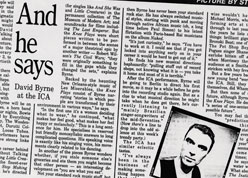ORIGINAL
PRESS CLIPPINGS

WILSON'S KNEE PLAYS AT ALICE TULLY HALL
"THE KNEE PLAYS" by Robert Wilson and David Byrne is presented as the American section of "The Civil Wars," Mr. Wilson's monumental, multilinear extravaganza. However, in keeping with the global aspect of the complete epic, "The Knee Plays" is decidedly international — with a specific Japanese flavor. In fact, one could regard the work as a Wilsonian ascent into Orientalism, as his "Noh Plays," with more than a touch of Bunraku and Kabuki. As seen in its New York premiere Tuesday at Alice Tully Hall, this is an eclectic piece, filled with visual puns; it is one of Mr. Wilson's most sheerly enjoyable and accessible works.
The 13 vignettes that comprise "The Knee Plays" are meant to be joints or connectives between the long acts of "Civil Wars." Extracted from the cycle and put together into an evening lasting 100 minutes, the "opera" is not simply a series of interludes. Instead, it is like an acrostic puzzle, a riddle that, once solved, assumes a new shape and significance. Parenthetically, the Knee Plays themselves have preludes, which perhaps one could call Elbow Plays.
At the core of the work is the art of transformation. Puppets become people and people, in masks, become puppets. A tree turns into a house, which turns into a boat. From the boat evolves a book, which then becomes a tree. Each object is represented by square modules — a cross between children's building blocks and Japanese screens — which regroup themselves into different arrangements. There are patterns within patterns. The tree is T-shaped. Struck by lightning, it becomes a tipped tree (or T). Later its foliage or wings are clipped and it sails to sea.
Orchestrating the regrouping is an elegant company of white-garbed dancers. Silently, they shift the scenery, manipulate the puppets, Bunraku-style, and achieve a life within the rebus of Mr. Wilson's fervid imagination. At the same time, a jazz band plays Mr. Byrne's score, infectious New Orleans-style music — slow drags and street marches — and an offstage narrator speaks a stream of Mr. Byrne's words.